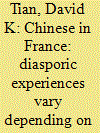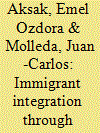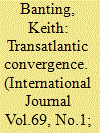|
|
|
Sort Order |
|
|
|
Items / Page
|
|
|
|
|
|
|
| Srl | Item |
| 1 |
ID:
166631


|
|
|
|
|
| Summary/Abstract |
The objective of this study is to identify the factors that contribute to the successful or unsuccessful integration of the Chinese diaspora in France. There is already a significant amount of literature that probes into the immigrant experiences of various other groups in France. However, the Chinese diaspora in France has remained insufficiently studied. This study aims to address this gap. The main findings of this study are that 1) unsurprisingly, the older the age of arrival, the less well integrated immigrants are in French society, 2) somewhat surprisingly, the less well integrated an immigrant is, the more likely he or she is going to believe that France is a tolerant and open-minded country, and 3) counterintuitively, the more deeply a member of the Chinese diaspora is immersed in French society, the more likely he or she is going to believe that France is hostile to people of Asian heritage.
|
|
|
|
|
|
|
|
|
|
|
|
|
|
|
|
| 2 |
ID:
165548


|
|
|
|
|
| Summary/Abstract |
Today, in all European countries, it is possible to identify a framework of policies addressing immigrants’ integration. By considering the various areas of policies concerned with such a phenomenon, the present study identifies the existence of shared patterns of responses across countries. I do so by introducing the concept of configuration of integration policies (CIP) and relying on a hierarchical cluster analysis. The analysis identifies two main shared-configurations for dealing with immigrant integration cutting across the East/West cleavage, with the Eastern configuration more restrictive than the Western one, especially in the areas of labor, education, political participation, and citizenship; they are, instead, closer to each other as they pertain to family, residence, and antidiscrimination; namely, in policy areas concerned with salient human rights issues and targeted by European directives. This evidence speaks to the broad debate in the field of immigrant integration policies, paving the way for further research and theoretical speculation.
|
|
|
|
|
|
|
|
|
|
|
|
|
|
|
|
| 3 |
ID:
187070


|
|
|
|
|
| Summary/Abstract |
In this paper, we problematise the relationship between racism and immigrant integration policies. First, we approach racism from its geopolitical/institutional/governmental logic and contextualise the emergence of integration policies across the European Union. Then, we put into dialogue the fieldwork materials of our research projects, analysing intersections between the EU and Spanish integration policy frameworks. Despite the inclusive and proactive rhetoric often expressed by integration policies, we illustrate the existence of an ‘elective affinity’ between racism and integration by focusing on: (1) the construction of migrants as a problematic ‘object’ of governmental intervention; (2) the reduction of racism to an individual pathology and the underestimation of its institutional/structural dimensions; (3) the reproduction of epistemic racism through the discourse on European (and national) values.
|
|
|
|
|
|
|
|
|
|
|
|
|
|
|
|
| 4 |
ID:
132525


|
|
|
|
|
| Publication |
2014.
|
| Summary/Abstract |
This research focuses on the European Union's (EU) public relations and public diplomacy efforts for immigrant integration. It uncovers the relationship between the EU and leaders of Turkish associations in Brussels, Belgium. In-depth interviews with Turkish association leaders reveal the way they see themselves and the Turkish diaspora, how they reflect on their national identities, and their understanding of EU public diplomacy and public relations strategies. The communication strategies Turkish associations use to gather information about immigrant integration and their opinions on EU communication strategies are also studied. In addition, the research investigates whether two-way communication exists between the Turkish associations and the EU, and unveils the strategic communication and public relations strategies the Turkish diaspora uses to influence public policy and to engage in lobbying.
|
|
|
|
|
|
|
|
|
|
|
|
|
|
|
|
| 5 |
ID:
129550


|
|
|
|
|
| Publication |
2014.
|
| Summary/Abstract |
At first glance, Canada and Europe seem to be diverging dramatically in their approach to immigrant integration. While support for a multicultural approach seems to remain strong in Canada, a potent backlash pervades European debates. This paper argues that beneath the image of transatlantic divergence, there are important elements of convergence. First, the retreat from multiculturalism in Europe is more complete at the level of discourse than policy. With a few notable exceptions, multicultural policies have remained stable or even grown stronger since 2000. In many countries, new integration programs are being layered over multicultural initiatives introduced in earlier decades. Second, many of the new integration policies celebrated as evidence of a U-turn away from multiculturalism resemble programs that have long been part of immigrant integration in Canada. As a result, transatlantic convergence is indeed part of the contemporary story. However, there are also limits to this convergence. While some European countries are opting for liberal, voluntary approaches to integration, which can be combined with a multicultural approach to diversity, others are adopting more obligatory, illiberal versions of civic integration that seem inconsistent with the support for diversity central to a multicultural approach.
|
|
|
|
|
|
|
|
|
|
|
|
|
|
|
|
|
|
|
|
|